Traditionally, confit is meat that's been marinated in salt and herbs, then slowly and gently cooked in its own fat. This mushroom confit recipe is similar and great for vegetarians, if you don't use duck fat.
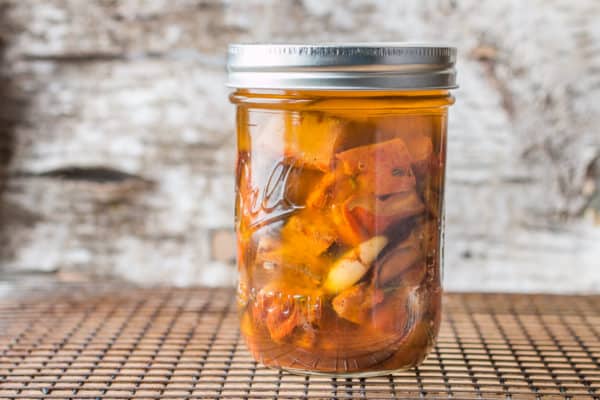
Confit isn't an everyday thing you'll make all the time but it's definitely a special treatment worth considering, especially if you have a bunch.
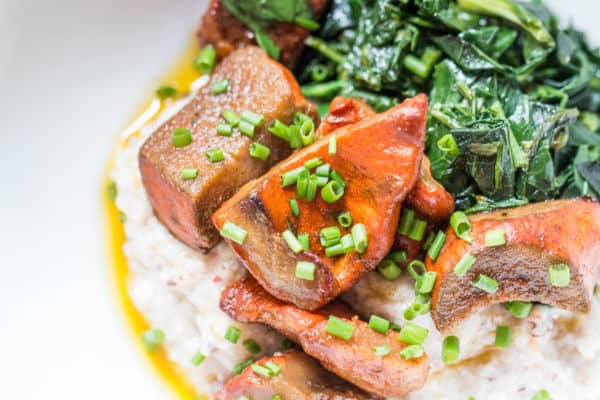
Confit mushrooms process
Cut the mushrooms into meaty pieces, weigh them, season them with 1% (or slightly more) of their weight in salt in grams, then mix them with a bunch of herbs, rest overnight, then cook slowly in lard or another fat.
This is a way I would preserve large amounts of mushrooms for restaurant service but you can easily store it in a mason jar. Just make sure everything is kept under fat.
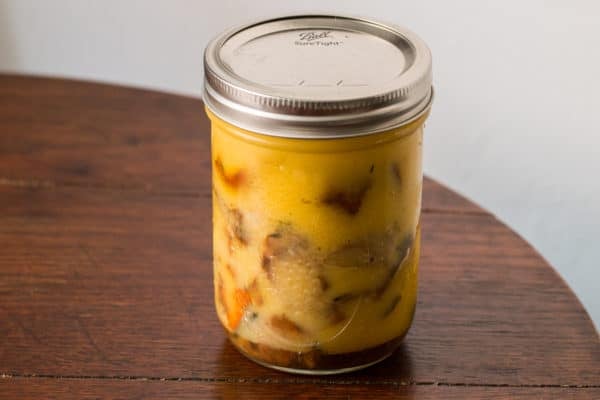
The Fat
Lard or duck fat is my first choice for confit since it gets firm, forming an air-tight seal. If you don't have rendered animal fat, you could substitute unsalted butter or oil.
When it's time to use the confit you simmer for a while, then ladle out pieces of mushroom and a drizzle of their fat onto what you're serving them with. Polenta with wilted greens is great.
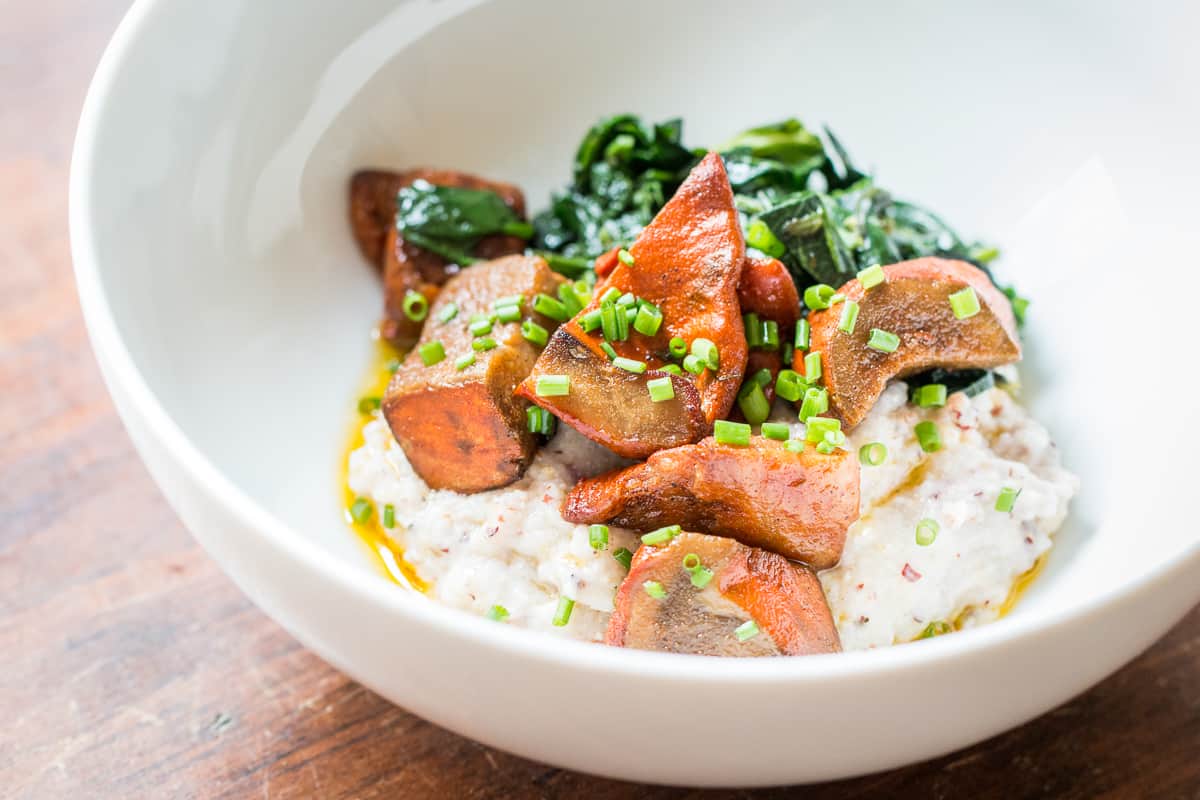
Safety
Confit is an ancient method of food preservation. Storing things like this at home isn't anything to be scared of, just make sure to reheat the mushrooms before you serve.
I use this in restaurants to extend the shelf life of wild mushrooms. If holding things under fat makes you nervous, keep them in the fridge and eat within a week.
Other mushrooms to use
Originally I used portobellos and shiitakes in restaurants, but Maitake confit is great too. Chicken of the Woods or Golden Chanterelles work too.
Wild Mushroom Confit
Ingredients
- 670 grams (1.5 lbs) mushrooms cleaned, trimmed, and cut into large pieces
- 10 grams (1.5 teaspoons) fine sea salt, or ground kosher salt (see note)
- 2 teaspoons paprika
- 1 teaspoon ground cumin
- 5 cloves of garlic crushed with the back of a knife
- 1 Tablespoon chopped thyme
- 1 large sprig of rosemary whacked with the back of a knife to release their aroma
- 2 dried bay leaves
- 1 tablespoon toasted black peppercorns
- 1000 grams (4 cups) melted lard or olive oil preferably from pork or poultry, although beef or lamb will work too
Instructions
- Cut the mushrooms into large pieces or halve them if small. In a large bowl, toss the mushrooms with the salt and all the ingredients except the lard and allow to rest in the fridge for 12-24 hours.
- Preheat the oven to 250. Remove the mushrooms and aromatics from the bowl, but leave any liquid behind, Squeeze the lobster mushrooms to remove juice.
- Add the mushrooms and aromatics to an oven-safe container. Leave 4 inches of headspace to avoid spills. Pour the melted fat over the mushrooms to cover them completely.
- Bake for 1.5 hours, then remove from the heat and transfer the mushrooms while piping hot to a mason jar, completely covering them with fat. Date and label the confit.
- The confit will keep for a month completely under lard, but can be used after a week or directly from the oven.

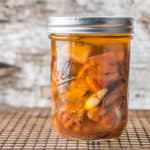
Adriana
Has anybody used this method with chanterelles?
Adriana
And...how much oil do you recommend? You do not specify a quantity above.
Alan Bergo
Doesn't need to be a lot. a couple tablespoons if you're doing it in a bag or sous vide (which I don't like to use). When I do this in restaurant settings I use lots of oil, as in a gallon or so for 5-10 lbs.
Alan Bergo
Chants would work fine here.
Carol
Hi Alan,
I really appreciate your information. It is unlike anything else I have found. The quality of your recipes, and their originality is really fabulous!
I would like to try your mushroom confit but can you give me an idea of the volume of oil you would normally use? Do you just cover the mushrooms?
Thanks again.
Michael Godin
Hello Chef
I've made this a few times now (the recipe is that good) with chanterelles and duck fat and I'm just wondering if a month is the max amount of time this will keep?
Alan Bergo
Hello. Sorry it took me some time to get to this. A month is not the longest it will keep, which is partly why I instruct people to heat the mushrooms before eating just as an extra precaution. It can likely last a very long time under refrigeration as there's no air, and the mushrooms are cooked and heavily salted. I list the timeline as a month as a general guideline as non-acid storage techniques are frowned on by the powers that be, if that makes any sense.
Rob
I'm wondering about the safety of this technique. Most wild mushrooms need to be cooked. But mushrooms cooked this way will never even really approach a boiling temperature, let alone the temperature that most mushrooms reach for several minutes when you fry them in hot oil.
Alan Bergo
Hi Rob, I understand your concern. This post does assume that the cook understand those basic precautions. In light of your comment, I have amended it to have a little more clarity for those new to cooking wild mushrooms, in the hopes they don't get some G.I. issues from preparing something like a leccinum this way. Rest assured though, left in the bag in the hot water for the time mentioned, the mushrooms will be fully cooked, I have been using this technique for years.
Rob
Ok, thanks. I don't see the updates, maybe I am missing something.
I tried this with Lactarius corrugis and the results were quite good. I ate half of one yesterday and so far so good 🙂
By the way, this blog is one of my favorites. I follow it consistently. I just fear it will make mushroom foraging and cooking a more popular hobby (!). That would mean less for those of us with a headstart.
Alan Bergo
Hi Rob. The updates are in the recipe method. It now says to bring the water to a boil and place the mushrooms in it, as well as a couple other little tweaks to ensure people cook their mushrooms thoroughly. I have had the GI once brought on from undercooked mushrooms (leccinum sp.), and it really sucks. The tricky part here is that I also needed to give an example of how I might use these after the slow cooking in oil. After cooking in oil, I usually heat them and their juice (past the point of boiling in a pan) to add as a garnish to other dishes, which negates any worry about undercooking. I didn't put anything in there about that though, so I'm going to now. Thanks for your thoughts.
Linda
Alan,
What is the longest you’ve let these sit under fat before eating?
I made a few jars last year and they’ve been in the refrigerator about a year. Wondering if they just need to be tossed out?
Alan Bergo
Hi Linda. So, typically I make this as an interesting way to serve mushrooms and I eat it within a few weeks. Life happens though and I'm guilty of forgetting about it too. The beauty of confit is that if the jars are sealed with fat, their hasn't been exposure to air and bacteria. What you'd need to do is empty the contents of the jars, fat and all into a pot, bring it to a simmer and cook for 15-20 minutes. Strain the fat from the mushrooms and add them to a recipe. The heating is a kill step here and should technically be fine, but I understand it can make people a little itchy/nervous. Also fine to toss them. Do whatever you feel comfortable with.